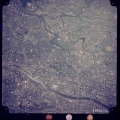Scale in Aerial Photography
Scale is the ratio of the distance between two points on an image to the actual distance between the same two points on the ground. Scale is an important describing factor of vertical aerial photography. It is important to know the scale of the image under examination, as this can affect how you perceive or interpret what appears in the image. Scale also allows features in the image to be measured.
Small-scale and Large-scale aerial images
Focal Length
Focal length is the distance between the camera lens and the film. The focal length of the lens affects the scale of the image captured. A camera with a lens of long focal length will produce images which look as if they have been taken close to the ground. Conversely a short focal length lens will produce smaller scale photographs which can look as if they have been taken at altitude.
The scale of a photograph (S) can also be expressed as the ratio between the focal length of the camera (f) and the altitude of the platform aircraft (H) in the equation S = H/f



